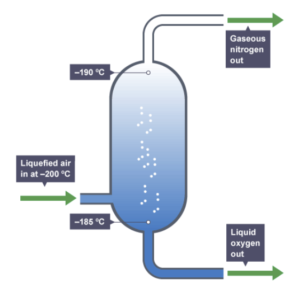Gases in the Atmosphere (GCSE Chemistry)
Gases in the Atmosphere
Atmospheric Gases
Proportions of Atmospheric Gases
- The atmosphere contains a mixture of gases. In the Earth’s atmosphere today, there are a mixture of gases, including about 80% nitrogen, about 20% oxygen and various other gases.
- Gases are found in different proportions. The different gases in the atmosphere are found in different amounts. These amounts have not changed over the last 200 million years.
- Nitrogen is the most abundant gas. In Earth’s atmosphere, nitrogen is the most abundant gas. It makes up about four-fifths of the Earth’s atmosphere. Oxygen makes up one-fifth of the Earth’s atmosphere and the remaining 1% are made up of traces of carbon dioxide (0.04%), water vapour and noble gases, like argon (0.9%)
Fractional Distillation of Air
Nitrogen and oxygen in air can be separated by the process of fractional distillation. Before entering the fractionating column, air is filtered to remove any excess particles such as dust. It is then cooled to 200 degrees where it becomes a liquid, therefore we can say it has been liquefied.

The temperature at the bottom of the fractionating column is higher than at the top.
Oxygen liquefies at -183°C, therefore liquid oxygen passes out through the bottom of the column. On the other hand, nitrogen liquefies -196°C, so gaseous nitrogen passes out through the top of the column. This allows us to separate nitrogen and oxygen from the air.
The Earth’s atmosphere is composed of 78% nitrogen, 21% oxygen, 1% argon, and trace amounts of other gases like carbon dioxide, neon, and methane.
Oxygen is essential for life on Earth as it is required for respiration by plants and animals. Oxygen helps to maintain the balance of gases in the atmosphere and also plays a role in atmospheric processes like combustion.
Carbon dioxide is important in the atmosphere as it is one of the main greenhouse gases. It helps to regulate the Earth’s temperature by trapping heat from the sun. However, increased levels of carbon dioxide can contribute to global warming and climate change.
The Earth’s atmosphere is composed of 78% nitrogen, 21% oxygen, 1% argon, and trace amounts of other gases like carbon dioxide, neon, and methane.
Even though trace gases make up only a small fraction of the atmosphere, they still play an important role in regulating the Earth’s climate and weather patterns. For example, methane is a potent greenhouse gas that can contribute to global warming.
The composition of the atmosphere can change over time due to human activities like deforestation and burning fossil fuels, which release large amounts of carbon dioxide into the atmosphere. Natural processes like volcanic eruptions and plant respiration can also affect the atmosphere’s composition.
The atmosphere protects life on Earth by filtering out harmful radiation from the sun, regulating temperature, and providing oxygen for respiration. The atmosphere also helps to protect the planet from meteor impacts by burning up incoming objects.
The ozone layer is a layer of ozone gas in the stratosphere that helps to protect life on Earth by absorbing harmful ultraviolet radiation from the sun. This radiation can cause skin cancer, harm crops, and harm marine life.
Yes, the composition of the atmosphere can be changed by both natural processes and human activities. Human activities like deforestation and burning fossil fuels can increase the amount of carbon dioxide in the atmosphere and contribute to global warming and climate change.





Still got a question? Leave a comment
Leave a comment